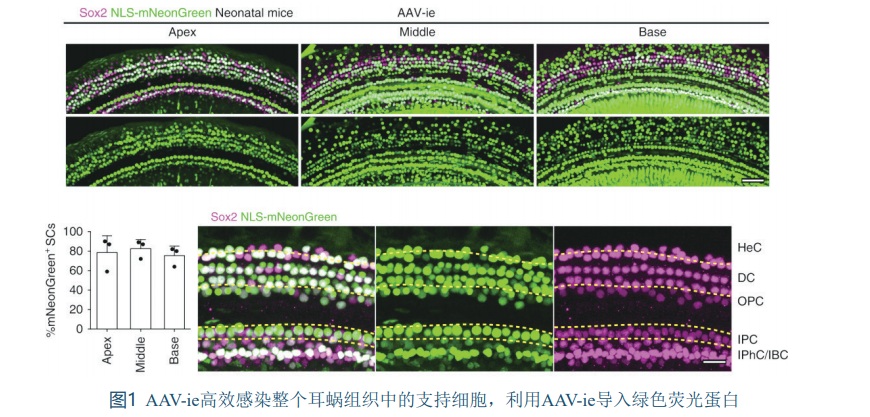

Advances in AAV-mediated gene therapy for hearing loss
Received date: 2020-10-01
Online published: 2021-02-25

KE Junzi, TAN Fangzhi, ZHONG Guisheng . Advances in AAV-mediated gene therapy for hearing loss [J]. Chinese Journal of Nature, 2021 , 43(1) : 39 -44 . DOI: 10.3969/j.issn.0253-9608.2021.01.006
[1] GBD 2015 Disease and Injury Incidence and Prevalence Collaborators. Global, regional, and national incidence, prevalence, and years lived with disability for 354 diseases and injuries for 195 countries and territories, 1990-2017: A systematic analysis for the global burden of disease study 2017 [J]. Lancet, 2018, 392(10159): 1789-1858.
[2] WILSON B S, TUCCI D L, MERSON M H, et al. Global hearing health care: new findings and perspectives [J]. Lancet, 2017, 390(10111): 2503-2515.
[3] LESICA N A. Why do hearing aids fail to restore normal auditory perception? [J]. Trends Neurosci, 2018, 41(4): 174-185.
[4] CARLSON M L, DRISCOLL C L, GIFFORD R H, et al. Cochlear implantation: current and future device options [J]. Otolaryngol Clin North Am, 2012, 45(1): 221-248.
[5] GAO X, TAO Y, LAMAS V, et al. Treatment of autosomal dominant hearing loss by in vivo delivery of genome editing agents [J]. Nature, 2018, 553(7687): 217-221.
[6] XIONG W, WAGNER T, YAN L, et al. Using injectoporation to deliver genes to mechanosensory hair cells [J]. Nat Protoc, 2014, 9(10): 2438-2449.
[7] HASTIE E, SAMULSKI R J. Adeno-associated virus at 50: a golden anniversary of discovery, research, and gene therapy success — a personal perspective [J]. Hum Gene Ther, 2015, 26(5): 257-265.
[8] NASO M F, TOMKOWICZ B, PERRY W L, et al. Adeno-associated virus (AAV) as a vector for gene therapy [J]. BioDrugs, 2017, 31(4): 317-334.
[9] ROSE J A, HOGGAN M D, SHATKIN A J. Nucleic acid from an adeno-associated virus: chemical and physical studies [J]. Proc Natl Acad Sci USA, 1966, 56(1): 86-92.
[10] ROSE J A, BERNS K I, HOGGAN M D, et al. Evidence for a single-stranded adenovirus-associated virus genome: formation of a DNA density hybrid on release of viral DNA [J]. Proc Natl Acad Sci USA, 1969, 64(3): 863-869.
[11] SAMULSKI R J, MUZYCZKA N. AAV-Mediated gene therapy for research and therapeutic purposes [J]. Annu Rev Virol, 2014, 1(1): 427-451.
[12] NAUMER M, SONNTAG F, SCHMIDT K, et al. Properties of the adeno-associated virus assembly-activating protein [J]. J Virol, 2012, 86(23): 13038-13048.
[13] EARLEY L F, POWERS J M, ADACHI K, et al. Adeno-associated virus (AAV) assembly-activating protein is not an essential requirement for capsid assembly of AAV serotypes 4, 5, and 11 [J]. J Virol, 2017, 91(3): e01980-16. doi:10.1128/JVI.01980-16.
[14] GAO G, VANDENBERGHE L H, WILSON J M. New recombinant serotypes of AAV vectors [J]. Curr Gene Ther, 2005, 5(3): 285-297.
[15] KEELER A M, FLOTTE T R. Recombinant adeno-associated virus gene therapy in light of luxturna (and zolgensma and glybera): Where are we, and how did we get here? [J]. Annu Rev Virol, 2019, 6(1): 601-621.
[16] RUSSELL S, BENNETT J, WELLMAN J A, et al. Efficacy and safety of voretigene neparvovec (AAV2-hRPE65v2) in patients with RPE65- mediated inherited retinal dystrophy: a randomised, controlled, openlabel, phase 3 trial [J]. Lancet, 2017, 390(10097): 849-860.
[17] LANDEGGER L D, PAN B, ASKEW C, et al. A synthetic AAV vector enables safe and efficient gene transfer to the mammalian inner ear [J]. Nat Biotechnol, 2017, 35(3): 280-284.
[18] SUZUKI J, HASHIMOTO K, XIAO R, et al. Cochlear gene therapy with ancestral AAV in adult mice: complete transduction of inner hair cells without cochlear dysfunction [J]. Sci Rep, 2017, 7: 45524.
[19] ISGRIG K, MCDOUGALD D S, ZHU J, et al. AAV2.7m8 is a powerful viral vector for inner ear gene therapy [J]. Nat Commun, 2019, 10(1): 427.
[20] WANG D, TAI P W L, GAO G. Adeno-associated virus vector as a platform for gene therapy delivery [J]. Nat Rev Drug Discov, 2019, 18(5): 358-378.
[21] OGDEN P J, KELSIC E D, SINAI S, et al. Comprehensive AAV capsid fitness landscape reveals a viral gene and enables machineguided design [J]. Science, 2019, 366(6469): 1139-1143.
[22] HARTL D, KREBS A R, JÜTTNER J, et al. Cis-regulatory landscapes of four cell types of the retina [J]. Nucleic Acids Res, 2017, 45(20): 11607-11621.
[23] LAN Y, TAO Y, WANG Y, et al. Recent development of AAV-based gene therapies for inner ear disorders [J]. Gene Ther, 2020, 27(7/8): 329-337.
[24] AKIL O, SEAL R P, BURKE K, et al. Restoration of hearing in the VGLUT3 knockout mouse using virally mediated gene therapy [J]. Neuron, 2012, 75(2): 283-293.
[25] PAN B, ASKEW C, GALVIN A, et al. Gene therapy restores auditory and vestibular function in a mouse model of Usher syndrome type 1c [J]. Nat Biotechnol, 2017, 35(3): 264-272.
[26] IIZUKA T, KAMIYA K, GOTOH S, et al. Perinatal Gjb2 gene transfer rescues hearing in a mouse model of hereditary deafness [J]. Hum Mol Genet, 2015, 24(13): 3651-3661.
[27] KIM M A, CHO H J, BAE S H, et al. Methionine sulfoxide reductase B3-targeted in utero gene therapy rescues hearing function in a mouse model of congenital sensorineural hearing loss [J]. Antioxid Redox Signal, 2016, 24(11): 590-602.
[28] CHANG Q, WANG J J, LI Q, et al. Virally mediated Kcnq1 gene replacement therapy in the immature scala media restores hearing in a mouse model of human Jervell and Lange-Nielsen deafness syndrome [J]. Embo Molecular Medicine, 2015, 7(8): 1077-1086.
[29] NIST-LUND C A, PAN B, PATTERSON A, et al. Improved TMC1 gene therapy restores hearing and balance in mice with genetic inner ear disorders [J]. Nat Commun, 2019, 10(1): 236.
[30] SHIBATA S B, RANUM P T, MOTEKI H, et al. RNA interference prevents autosomal-dominant hearing loss [J]. Am J Hum Genet, 2016, 98(6): 1101-1113.
[31] GYORGY B, NIST-LUND C, PAN B, et al. Allele-specific gene editing prevents deafness in a model of dominant progressive hearing loss [J]. Nat Med, 2019, 25(7): 1123-1130.
[32] ESTIVILL X, FORTINA P, SURREY S, et al. Connexin-26 mutations in sporadic and inherited sensorineural deafness [J]. Lancet, 1998, 351(9100): 394-398.
/
| 〈 |
|
〉 |